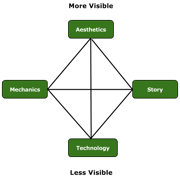("Classic Game Model" and "Elemental Tetrad" redirect here.)
According to the online Merriam-Webster dictionary, a game is "a physical or mental activity or contest that has rules and that people do for pleasure." Of course, in the game industry, the term is very debatable.
Jesper Juul's Classic Game Model[]
In the second chapter of his book, Half Real: Video Games between Real Rules and Fictional Worlds, Jesper Juul compares multiple perspectives and definitions of game design and combines them into a formal definition he calls the "classic game model." According to this model, games contain six distinct features:
- Fixed Rules
- Variable, quantifiable outcomes (The definition of what establishes a goal is understood)
- Values associated with each outcome (Win = positive, lose = negative)
- Player effort (Challenges)
- Player attachment (Player cares about outcome)
- Negotiable Consequences (May optionally be given real life consequences, like gambling)
"In short form: A game is a rule-based formal system with a variable and quantifiable outcome, where different coutcomes are assigned different values, the player exerts effort in order to influence the outcome, the player feels attached to the outcome, and the consequences of the activity are optional and negotiable (Juul 36)."
Under this definition, some classically defined games would include chess, soccer, and many real-time strategy or platformer video games. Things like free form play, hypertext fiction, and ring-around-the-roses would not be considered games, as they are deficient in most of the characteristics of the classical game model (Juul 44).
Juul realizes the problems this definition may cause, and in his book allows for multiple "borderline cases," games that fulfill some of these characteristics, but not all. These include skill-based gambling, games of pure chance, and open-ended simulations like SimCity. He also mentions that, especially in relation to video games, "the classic game model is no longer all there is to games," but still maintains that the model is useful because of its wide application to a majority of what we call "games" (Juul 53).
The model also serves to emphasize that games, like stories, are transmedial, an important assumption of ludology.
Jesse Schell's Elemental Tetrad[]
In The Art of Game Design: A Book of Lenses, designer Jesse Schell defines a game as "a problem solving activity, approached with a playful attitude" (37). That being said, he holds the definition "only has value if they give you some insight into making better games," and is far from a formal ontology (37).
Further, games are gateways to experiences that the designer is trying to create, rather than merely stand-alone objects. All games are made up of four basic elements:
1. Mechanics -- The procedures, rules, and goals of a game. This is the element that sets games apart from
Elemental Tetrad
2. Story -- The sequence of events that unfolds in a game, and a large part of the game's fictional world. It may be progressive and linear or emerge from gameplay choices.
3. Aesthetics -- how a game looks, sounds, smells, tastes, and feels. This element is the most readily apparent to players and helps encourage immersion in the game's fictional world.
4. Technology -- Any materials and interactions that make the game possible, from paper and pencils to computerized hardware. It sets the limitations for the other elements, and also ought to guide the design process in a way that syncs with these limitations.
Together, these make up what he calls the Elemental Tetrad (41). No one element is more important than another; all have an equal impact on the overall experience the game attempts to create.
Raph Koster's Definitions[]
In chapter 2 of A Theory of Fun for Game Design, Raph Koster provides multiple definitions taken from people all over the game industry:
- Jesper Juul calls a game "a rule-based formal system with a variable and quantifiable outcome, where different outcomes are assigned different values, the player exerts effort in order to influence the outcome, the player feels attached to the outcome, and the consequences of the activity are optional and negotiable" (Koster 12)
- Chris Crawford holds that "games are a subset of entertainment limited to conflicts in which players work to foil each other's goals" (14)
- Sid Meier, game designer behind the Civilization series, calls games "a series of meaningful choices" (14)
- Ernest Adams and Andrew Rollings define a game as "one or more causlly linked series of challenges in a simulated environment" (14).
- Katie Salen and Andrew Zimmerman offer this definition in Rules of Play: "a game is a system in which players engage in an artificial conflict, defined by rules, that results in a quantifiable outcome" (Koster 14).
Koster's own definition portrays games as "exceptionally tasty patterns to eat up," places where learning is the outcome (14). To be more specific, they present us with models of real things, these models are generally quantified, they generally teach us things that can be absorbed into the unconscious, and mostly teach primitive behaviors (though this can change) (Koster 76). Generally, they contain two parts: the formal abstract system (the rules and mechanics) and the dressing (the fictive context in which games are set). Both affect the game as a whole, but Koster argues that the formal part must be developed if the industry is to evolve.